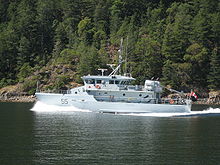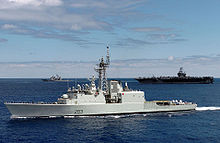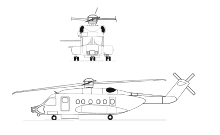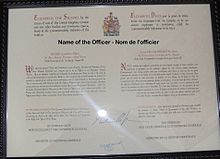- Royal Canadian Navy
-
Royal Canadian Navy 
Logo of the Royal Canadian Navy
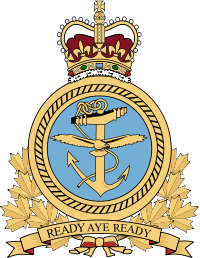
Badge of the Royal Canadian NavyActive 1910–Present Country  Canada
CanadaType Navy Size 8,500 regular personnel
5,100 reserve personnelPart of Canadian Forces Headquarters NDHQ Motto Ready Aye Ready March Heart of Oak Mascot SONAR (Newfoundland dog) Engagements First World War
Second World War
Korean War
Persian Gulf War
Afghanistan War
Somali War
Operation MOBILEWebsite navy.forces.gc.ca Commanders Chief of the Defence Staff General Walter Natynczyk CMM, MSC, CD Chief of the Maritime Staff Vice-Admiral Paul Maddison OMM, MSM, CD Assistant Chief of the Maritime Staff Rear-Admiral M.A.G. Norman CD Insignia Naval Jack of Canada (1968-present) 
Naval Jack of Canada (1957-1965) 
Naval Jack of Canada (1921-1957) 
The Royal Canadian Navy (RCN) (French: Marine royale canadienne), is the naval force of Canada. The RCN is one of three environmental commands within the unified Canadian Forces. Operating 33 warships and several auxiliary vessels, the Royal Canadian Navy consists of 8,500 Regular Force and 5,100 Primary Reserve sailors, supported by 5,300 civilians.[a 1] Its current commander is Vice-Admiral Paul Maddison, OMM, MSM, CD, Commander Royal Canadian Navy.[a 2]
Founded in 1910 as the Naval Service of Canada and given royal sanction in 1911, the RCN was placed under the Department of National Defence in 1923, and amalgamated with the Royal Canadian Air Force and the Canadian Army to form the unified Canadian Forces in 1968, where it was known as the Maritime Command until 2011. Over the course of its history, the RCN served in the First and Second World Wars, the Korean War, the First Gulf War, the Afghanistan War and numerous United Nations peacekeeping missions and NATO operations.
Contents
History
1910–1968
Established following the introduction of the Naval Service Bill by then-Prime Minister Sir Wilfrid Laurier, the Naval Service of Canada was intended as a distinct naval force for the Dominion, that, if necessary, could be placed under British control. The bill received royal assent on 4 May 1910. Initially equipped with two former Royal Navy vessels, HMCS Niobe and HMCS Rainbow, the service was renamed Royal Canadian Navy by King George V on 29 August 1911.[1]
During the first years of the First World War, the RCN's six-vessel naval force patrolled both the North American West and East coasts to deter the German naval threat, with a seventh ship, HMCS Shearwater joining the force in 1915. Just before the end of the war in 1918, the Royal Canadian Naval Air Service was established with the purpose of carrying out anti-submarine operations; however, it was disbanded after the armistice of 11 November.[2]
After the war, the Royal Canadian Navy overtook certain responsibilities of the Department of Transport's Marine Service, and slowly started to rebuild its fleet, with the first warships specifically designed for the RCN being commissioned in 1932.[3] At the outbreak of the Second World War, the Navy had 11 combat vessels, 145 officers and 1,674 men.[4] During the Second World War, the Royal Canadian Navy expanded significantly, ultimately gaining responsibility for the entire Northwest Atlantic theatre of war. By the end of the war, the RCN had become the third-largest allied navy in the world after the United States Navy and the Royal Navy. During the Battle of the Atlantic, the RCN sank 27 U-boats and sank or captured 42 enemy surface vessels, while successfully completing 25,343 merchant crossings. The navy lost 24 ships and 1,797 sailors in the war.[5]
From 1950 to 1955, during the Korean War, Canadian destroyers maintained a presence off the Korean peninsula, engaged in shore bombardments and maritime interdition. During the Cold War, the navy developed an anti-submarine capability to counter the growing Soviet naval threat.[6][7] In the 1960s, the Royal Canadian Navy retired most of its Second World War vessels, and further developed its anti-submarine warfare capabilities by acquiring the Sikorsky CH-124 Sea King, pioneering the use of large maritime helicopters on small surface vessels. At that time, Canada was also operating an aircraft carrier, HMCS Bonaventure, operating the McDonnell F2H Banshee fighter jet until 1962, as well as various other anti-submarine aircraft.[2]
1968–present
In 1968, under the Liberal government of Lester B. Pearson, the Royal Canadian Navy, Royal Canadian Air Force and Canadian Army were amalgamated to form what is today the Canadian Forces, a single command structure under the Department of National Defence, at the time overseen by Defence Minister Paul Hellyer. The controversial merger saw the Royal Canadian Navy re-designated as Maritime Command (MARCOM), forcing sailors and shore-based personnel to adopt the common Canadian Forces rifle green uniform. Ship-borne and shore-based aircraft in support of MARCOM were organized into the "Maritime Air Group" which came under MARCOM command; in 1975 the Maritime Air Group units and equipment were transferred to the newly formed Air Command (now renamed the Royal Canadian Air Force). The unification of the Canadian Forces in 1968 is the first time a nation with a modern military combined its sea, land and air elements under a single structure.
The 1970s and 1980s saw a rationalizing of MARCOM's fleet, with the addition of the Iroquois class destroyer, which were later updated to air-defence destroyers, and the construction of the Halifax class frigate into the mid-1990s. Several fleet rationalization proposals were made during this era, both by the civil service and the Department of National Defence, as well as by the Centre for Military and Strategic Studies. In 1990, Canada deployed three warships to support the Operation Friction. Later in the decade, MARCOM deployed ships to patrol the Adriatic Sea during the Yugoslav Wars and the Kosovo War. More recently, Maritime Command provided vessels to serve under Operation Apollo and to combat piracy off the coast of Somalia.
The Conservative government of Stephen Harper announced on August 16, 2011 that Maritime Command was to regain its former name, the Royal Canadian Navy.
Structure
The Royal Canadian Navy is headquartered at National Defence Headquarters (NDHQ) in Ottawa, Ontario. Since 1968, the Royal Canadian Navy is an environmental command of the Canadian Forces, charged with maintaining and generating forces for one of four operational commands, primarily Canada Command and the Expeditionary Command, but also the Canadian Operational Support Command and to a lesser extent, the Canadian Special Operations Forces Command.[a 1]
Maritime Forces Atlantic
The Royal Canadian Navy's Atlantic Fleet, known as Maritime Forces Atlantic (MARLANT), is headquartered and homeported at CFB Halifax in Halifax, Nova Scotia and is supported by CFS St. John's in Newfoundland. Attached to MARLANT and CFB Halifax is Royal Canadian Air Force's 12 Wing Shearwater, based at Shearwater Heliport, which provides shipborne air support for the Atlantic Fleet. The RCAF's 14 Wing Greenwood provides fixed-wing air support for MARLANT through 404 Maritime Patrol and Training Squadron and 405 Maritime Patrol Squadron. Other Atlantic Fleet facilities are CFAD Bedford, an ammunition depot, and two radio stations, Naval Radio Section (NRS) Newport Corner and NRS Mill Cove.[a 3]
The Atlantic Fleet, with 19 warships and a number of auxiliary vessels, is responsible for Canada's Exclusive Economic Zone on the East Coast, as well as Canada's Area of Responsibility in the Atlantic Ocean and the eastern Arctic Ocean.
Maritime Forces Pacific
The Royal Canadian Navy's Pacific Fleet, known as Maritime Forces Pacific or MARPAC, is headquartered at CFB Esquimalt in British Columbia. Staffed by 4,000 military personnel and 2,000 civilian personnel, the organization is commanded by Rear-Admiral Nigel S. Greenwood.[a 4]
With fourteen warships and several auxiliary vessels homeported in Esquimalt, the Pacific Fleet is responsible for Canada' Exclusive Economic Zone on the West Coast and Canada's Area of Responsibility in the Pacific Ocean and the western Arctic Ocean. Fleet Naval Facility Cape Breton provides repair and maintenance services to the Pacific Fleet. The Royal Canadian Air Force's 443 Maritime Helicopter Squadron, based at Patricia Bay Heliport but under the control of 12 Wing Shearwater, provides shipborne helicopter support for the Pacific Fleet, while 19 Wing Comox provides fixed wing maritime air support for MARPAC through 407 Long Range Patrol Squadron.
Reserve
The Naval Reserve Headquarters (NAVRESHQ), located at the Pointe-a-Carcy Naval Complex in Quebec City, Quebec, is responsible for twenty four Naval Reserve Divisions across the country. The base is also home to Canadian Forces Fleet School Quebec and HMCS Montcalm. The Naval Reserve, composed of 4,000 reservists, is commanded by Commodore David W. Craig, CD.[a 5]
Fleet
Warships
The Navy operates 29 surface warships and 4 submarines. The surface ships carry the designation Her Majesty's Canadian Ship (HMCS) : three Iroquois class guided-missile destroyers, twelve Halifax class multi-role patrol frigates, twelve Kingston class coastal defence vessels, and two Protecteur class replenishment vessels. In addition to the surface vessels, the RCN owns 4 currently inactive Victoria class submarines acquired from the Royal Navy in 1998. These warships carry the designation Her Majesty's Canadian Submarine. The Royal Canadian Navy also maintains and operates HMCS Oriole, a historic sail ship commissioned in 1921 that now serves as a sail training vessel. Although it carries the royal designation, it is not counted as an active warship of the Royal Canadian Navy.
Auxiliary vessels
The RCN operates auxiliary vessels to support the Canadian Forces, these vessels are not warships and do not carry the HMCS designation. Among the auxiliary ships operated by the Navy are eight Orca class patrol vessels, five Ville class harbour tugs, five Glen class harbour tugs and two fireboats of the Fire class.
Aircraft
Since 1975, the maritime support aircraft are operated by the Royal Canadian Air Force through the 1 Canadian Division and 12 Wing Shearwater on behalf of the Royal Canadian Navy. The RCAF operates twenty seven Sikorsky CH-124 Sea King helicopters in the anti-submarine warfare and search and rescue role, eighteen Lockheed CP-140 Aurora in anti-submarine warfare and area surveillance role, and one CP-140A Arcturus in strategic surveillance role.
Future
Several programs are underway to modernize the RCN fleet. The Joint Support Ship Project is a program to replace the current Protecteur class resplenishment vessels with two to three new joint support ships, providing support to naval task groups, a limited sealift capability and limited theatre command and control.[a 6] The Arctic Patrol Ship Project, announced in 2007, is a program to build six to eight polar class arctic offshore patrol ships and to establish the Nanisivik Naval Facility, a deep water port in Nunavut.[a 7] The Halifax-class frigate is currently undergoing a mid-life extension program,[a 8] while the 24 Sea King helicopters that currently provide shipborne air support for the Navy frigates and destroyers are set to be replaced by 28 Sikorsky CH-148 Cyclones.[a 9] A CBC News report has suggested that the RCN is considering the purchase of nuclear submarines to replace the diesel-electric Victoria-class submarine fleet; however, no agenda has been tabled publicly by the Canadian government.[8]
Personnel
Commissioned officers
Commissioned officers of the Canadian Forces have pay grades ranging from OF-1 to OF-9. The only OF-9 position in the Canadian Forces is the Chief of the Defence Staff, who may or may not be from the Navy. The highest position occupied in the current Royal Canadian Navy structure is OF-8, a Vice-Admiral who serves as the Chief of the Maritime Staff. OF-6 (Commodore) to OF-9 (Admiral) are referred to as flag officers, OF-3 (Lieutenant-Commander) to OF-5 (Captain(N)) are referred to as senior officers, while OF-2 (Lieutenant(N)) and OF-1 (Sub-Lieutenant) are referred to as junior officers. Naval Cadets are referred to as subordinate officers.[a 10] All officers of the Canadian Forces receive a commission from Her Majesty Queen Elizabeth the Second, Queen of Canada. The Commissioning Scroll issued in recognition of the commission is signed by the Governor General of Canada as Commander-in-Chief and the serving Minister of National Defence.
Naval officers are trained at the Royal Military College of Canada in Kingston, Ontario, the Royal Military College Saint-Jean in Saint-Jean, Quebec and the Naval Officer Training Centre VENTURE in Work Point, Esquimalt, British Columbia. Some specialized candidates may be commissioned without attending the Royal Military College, the plan is known as Direct Entry Officer (DEO) Plan.
Commissioned Officer Rank Structure of the Royal Canadian Navy Commander-in-Chief Admiral Vice Admiral Rear Admiral Commodore Captain N/A OF-9 OF-8 OF-7 OF-6 OF-5 








C-in-C Adm VAdm RAdm Cmdre Capt(N) Commander Lieutenant-Commander Lieutenant Sub-Lieutenant Acting Sub-Lieutenant Naval Cadet OF-4 OF-3 OF-2 OF-1 Cadet 





Cdr LCdr Lt(N) SLt A/Slt NCdt Non-commissioned members
Non-commissioned members of the Royal Canadian Navy have pay grades ranging from OR-2 to OR-9. OR-9 (Chief Petty Officer 1st Class), OR-8 (Chief Petty Officers 2nd Class) and OR-7 (Petty Officer 1st Class) are known as petty officers, and together with OR-6 (Petty Officer 2nd Class, referred to as senior non-commissioned officer) form the senior cadre of the non-commissioned (enlisted) members of the military. OR-5 (Master Seaman) and OR-4 (Leading Seaman) are referred to as junior non-commissioned officers, while OR-3 (Able Seaman) and OR-2 (Ordinary Seaman) are referred to as privates.
All regular force non-commissioned members of the Canadian Forces undergo basic training at the Canadian Forces Leadership and Recruit School in Saint-Jean-sur-Richelieu. Recruits then attend occupation-specific training at various locations across Canada.
Non-Commissioned Member Rank Structure of the Royal Canadian Navy Chief Petty Officer 1st Class Chief Petty Officer 2nd Class Petty Officer 1st Class Petty Officer 2nd Class Master Seaman Leading Seaman Able Seaman Ordinary Seaman OR-9 OR-8 OR-7 OR-6 OR-5 OR-4 OR-3 OR-2 







CPO1 CPO2 PO1 PO2 MS LS AB OS Traditions
Colours
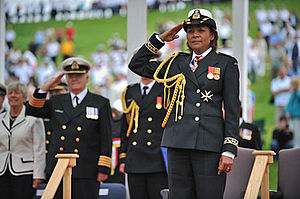 Former Governor General Michaëlle Jean acting in the Queen's name as Commander-in-Chief of the Canadian Forces and wears the naval uniform while presenting the newly consecrated Queen's Colour to the Canadian Forces Maritime Command, 27 June 2009
Former Governor General Michaëlle Jean acting in the Queen's name as Commander-in-Chief of the Canadian Forces and wears the naval uniform while presenting the newly consecrated Queen's Colour to the Canadian Forces Maritime Command, 27 June 2009
The Queen's or King's Ceremonial colours (also referred to as the Sovereign's Colour) for the navy has been presented/consecrated four times: in 1939 by King George VI in Esquimalt, BC, in 1959 by Queen Elizabeth II and Prince Phillip in Halifax, NS, in 1979 by the Queen Mother in Halifax, NS and in 2009 by the Governor General of Canada and Commander-in-Chief Michaëlle Jean in Halifax, NS.[9] The colours consists of a ceremonial standard with the Maple Leaf flag in the top left canton, the monarch's Royal Cypher for Canada (a capital E on a blue background, surrounded by a circlet of gold Tudor roses and laurels, surmounted by a crown) and an anchor (from the Royal Canadian Navy's naval jack) on the lower right fly. These elements are found on the 1979 and 2009 colours. The colours from 1959 and 1939 consisted of a Royal Navy white ensign with the Queen's or King's cipher in the middle.[9]
The use of the service colours of the Royal Navy were granted to the RCN in 1925. Two service colours were sent to Halifax and Esquimalt. In 1937 they were retired, and new colours sent. The official presentation of the King's Colour was not completed until 1939.[9] The Royal Canadian Navy's retired colours are laid up at Beechwood Cemetery in Ottawa, Ontario.[9]
Heritage
This history of Royal Canadian Navy is preserved and presented at the Maritime Command Museum in Halifax, the Canadian War Museum, the Naval Museum of Alberta and naval museums on several bases. Several Royal Canadian Navy vessels have been preserved including the hydrofoil HMCS Bras d'Or and the submarines Ojibwa and Onondaga. The corvette HMCS Sackville serves as Canada's Naval Memorial. A monument at Point Pleasant Park in Halifax commemorates members of Royal Canadian Navy who have died in peacetime.
See also
- Canadian Coast Guard
- Canadian Army
- Royal Canadian Air Force
References
- The Department of National Defence and the Canadian Forces
- ^ a b Canada’s Navy at a Glance, National Defence and the Canadian Forces, 16 August 2011, archived from the original on 17 August 2011, http://www.webcitation.org/610zOp2Br
- ^ Biography: Vice-Admiral Paul Maddison, Royal Canadian Navy, 16 August 2011, archived from the original on 17 August 2011, http://www.webcitation.org/610zaKnTj
- ^ Maritime Forces Atlantic, Royal Canadian Navy, archived from the original on 17 August 2011, http://www.webcitation.org/611CB8bTJ
- ^ Rear-Admiral Nigel S. Greenwood, Royal Canadian Navy, archived from the original on 17 August 2011, http://www.webcitation.org/6119KhuTm
- ^ Canada Begins Joint Support Ships Procurement for the Canadian Forces, National Defence and the Canadian Forces, 14 July 2010, archived from the original on 17 August 2011, http://www.webcitation.org/610yExx6N
- ^ Arctic/Offshore Patrol Ships, National Defence and the Canadian Forces, 5 August 2011, archived from the original on 17 August 2011, http://www.webcitation.org/610ydJfQl
- ^ Halifax-Class Modernization And Life Extension, National Defence and the Canadian Forces, 1 October 2010, archived from the original on 17 August 2011, http://www.webcitation.org/610z3xuTu
- ^ Maritime Helicopter Project, National Defence and the Canadian Forces, 26 July 2010, archived from the original on 17 August 2011, http://www.webcitation.org/610zEcnaJ
- ^ Royal Canadian Navy Rank and Appointment Insignia, Royal Canadian Navy, 16 August 2011, archived from the original on 19 August 2011, http://www.webcitation.org/614HhxBDj
- Other references
- ^ Gibert Norman Tucker, The Naval Service of Canada: Volume I: Origins and Early Years, (Ottawa: King's Printer, 1952), 137.
- ^ Marc Milner, "Walter Hose To The Rescue: Navy, Part 13", Legion Magazine, 01 January 2006. Accessed 02 May 2010.
- ^ Schull, Joseph, Far Distant Ships: An Official Account of Canadian Naval Operations in World War II, King's Printer, Ottawa, 1952 - reprinted by Stoddart Publishing, Toronto, 1987, ISBN 0-7737-2160-6 p.1
- ^ Schull, Joseph, p.430-1
- ^ Thor Thorgrimsson and E.C. Russell, Canadian Naval Operations in Korean Waters, 1950-1955, (Ottawa: Queen's Printer, 1965). Retrieved 09 May 2010.
- ^ Marc Milner, Canada's Navy: The First Century, (Toronto: University of Toronto Press, 1999), p. 207-209, ISBN 0-8020-4281-3.
- ^ Canada May Buy Nuclear Submarines, Canadian Broadcasting Corporation, 27 October 2011, http://www.cbc.ca/news/politics/story/2011/10/27/submarines-british-nuclear.html
- ^ a b c d "Queen's Colours (Canada)". Flagspot. http://flagspot.net/flags/ca%5Eqclrs.html. Retrieved 4 March 2011.
Further reading
- Milner, Marc (2010), Canada's Navy: The First Century, Univ. of Toronto Press, ISBN 0802096042, http://books.google.ca/books?id=afOEdO8mh1gC&lpg=PP1&dq=Canada's%20Navy%3A&pg=PP1#v=onepage&q&f=true
- Hadley, Michael L (1996), A nation's navy: in quest of Canadian naval identity, McGill-Queen's University Press, ISBN 0773515062, http://books.google.ca/books?id=pDFFeppU93MC&lpg=PA339&dq=Canadian%20Forces%20Maritime%20Command&pg=PP1#v=onepage&q&f=true
External links
 Canadian Forces
Canadian Forces Commander-in-Chief • Chief of the Defence Staff • Armed Forces Council • Chief of the Maritime Staff • Chief of the Land Staff • Chief of the Air Staff
Canada Command • Canadian Expeditionary Force Command • Canadian Operational Support Command • Canadian Special Operations Forces Command • Reserve Force
 Royal Canadian Navy •
Royal Canadian Navy •  Canadian Army •
Canadian Army •  Royal Canadian Air Force
Royal Canadian Air Force Category ·
Category ·  Portal ·
Portal ·  WikiProject
WikiProject Royal Canadian Navy
Royal Canadian Navy 
Components History Ships Aircraft (RCAF) Bases CFB Esquimalt • CFB Halifax • CFS St. John's • CFMETR, Nanoose Bay • NRS Aldergrove • NRS Newport Corner • NRS Mill Cove Category ·
Category ·  Portal ·
Portal ·  WikiProject
WikiProjectCurrent Canadian Forces History of the Canadian Forces History of the Canadian Army · History of the Royal Canadian Air Force · History of the Royal Canadian NavyCanadian military formation Canadian Expeditionary Force · (Permanent Active Militia · Non-Permanent Active Militia) · Royal Flying Corps Canada · Naval Service of CanadaMilitary formation in British North America Provincial Marine · Royal Navy · British Army (regulars, provincial regiments and volunteer militia units)Military formation in New France  Category ·
Category ·  Portal ·
Portal ·  WikiProjectCategories:
WikiProjectCategories:- Royal Canadian Navy
- Naval history of Canada
Wikimedia Foundation. 2010.


